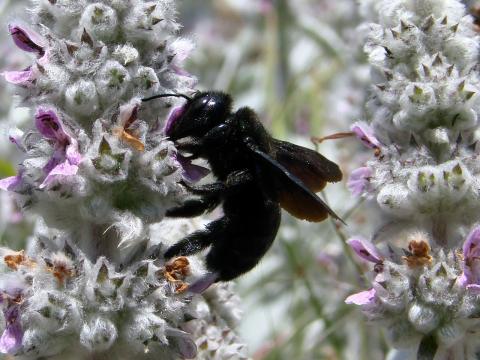
There's a lot of buzz about pollination, the transfer of pollen between flowers that's key to plant growth and reproduction.
It's why Cathy Neal, Extension Professor and specialist in landscape horticulture with UNH Cooperative Extension, is standing in a field at Woodman Horticultural Research Farm on a warm June day, answering visitor questions about wildflowers and meadows. Working alongside colleagues from the NH Agricultural Experiment Station (NHAES), Neal studies wildflower meadows as habitats for pollinators – bees, butterflies, hummingbirds, and other animals and insects that transfer pollen from one flower to another.
"Wildflower meadows serve many ecological functions but, as interest in pollinators has exploded, the focus is on identifying native plants that best support them," she says. "Especially during seasons when there aren't abundant flowers available."
When Neal began studying wildflower meadows eight years ago, she was interested primarily in how to create low-maintenance, sustainable landscapes. Now, her research is driven by international concern over shrinking bee populations. According to the Food and Agriculture Organization of the United Nations, pollinators, including bees, pollinate 75% of the world's food crops – roughly a third of all crop production – enabling fruit and seeds to grow.
The value of pollination to agriculture is estimated at more than $200 billion a year worldwide.
Wildflowers at Woodman
Naturally-occurring meadows are rare in New Hampshire, because most of the state is wooded. "What we call meadows are really pastures that haven't been mowed or are abandoned," says Neal, “mostly full of non-native grasses and weeds, although asters and goldenrods are native plants with high pollinator value”. She and her team have established five wildflower meadows at Woodman, each with a different research focus. Their work includes tracking how many seeds to plant per square foot for optimal density, diversity and bloom production. They are also monitoring the number and types of bees visiting the meadows, and studying how plants respond to changes in weather and soil. Neal’s team maintains a reference garden to help identify dozens of wildflower species that they've planted throughout the meadows.
Creating a habitat
Creating a wildflower habitat does require more than sprinkling a package of flower seeds throughout the yard. Patience is key: it takes three years to establish a meadow from seed. The first season should be spent killing out the existing grasses and other vegetation in the area, and Neal is conducting research on the best ways to do this – solarization with clear plastic, smothering with black plastic, repeated mowing or tilling, or use of herbicides. Each method has advantages and disadvantages. Seeds may be planted in either spring or fall. The next year, expect a lot of weeds and not many flowers, as the wildflowers mostly grow roots and leaves the first season. Once the third year arrives, however, you’ll be pleasantly surprised by the rapid growth and flowering of the wildflower mix.
Even small groupings of native perennials like coneflowers or black-eyed Susans can benefit bees and other pollinators (see Neal's list of pollinator-friendly flowers tested for planting success). "That's what's great about planting wildflowers," Neal says. "You can go small or large-scale. Either way, you're making a difference."
Learn more about how to establish a wildflower meadow habitat. This project is funded by the USDA-NIFA.

